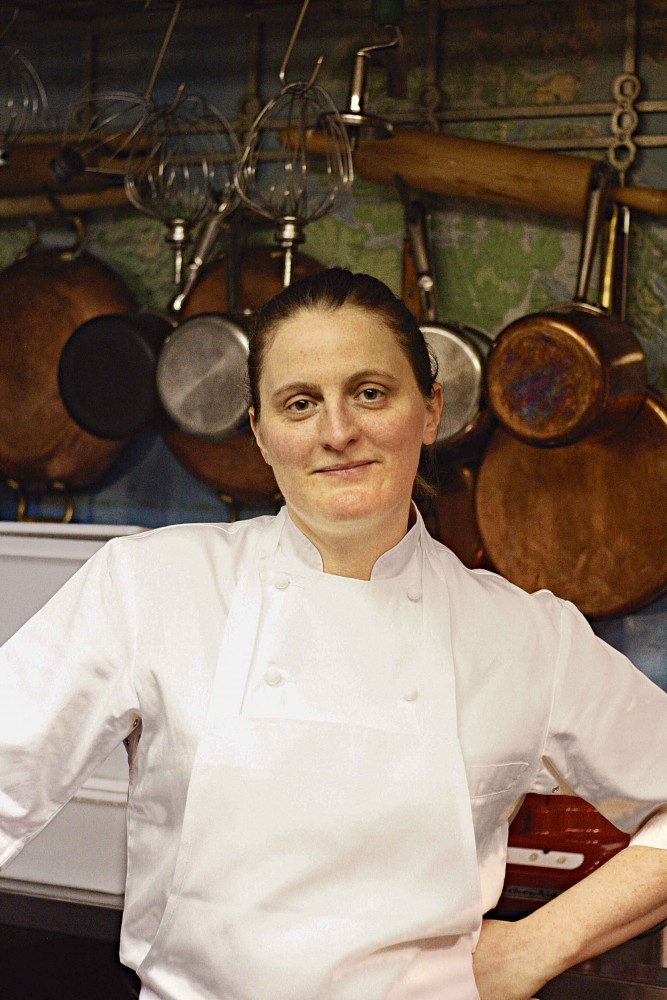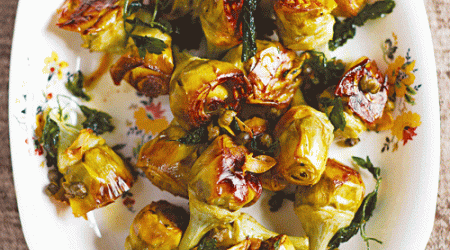April Bloomfield
One of Britain's best culinary exports, chef and author April Bloomfield forged her trade in London before taking her cool, uncompromising cooking to New York, says Mark Sansom. But will she return home?April Bloomfield cuts the figure of a slightly dishevelled rock star as she strides through the lobby of London’s Bulgari Hotel. A heavily faded band T-shirt, oversized wraparound shades and hair scraped back in a knotted bun cause the assembled suits’ heads to pivot; she couldn’t care less. In the same way, she has cut a swathe through the transatlantic food scene, so turning up under-dressed in a five-star establishment is the last thing that’s going to phase her.
She’s fresh from her adopted hometown of New York, by way of lunch at Trishna, her favourite Indian restaurant in London. ‘Big morning. Where’s the coffee?’ she asks, keeping the rock-star guise alive. In spite of the zero sleep, a Karam Sethi seven-courser and the thought of an afternoon with a journalist, as soon as the glasses come off and we get onto the subject of food, the eye-glaze vanishes and she zeroes in.
‘I’ve just got back from New Orleans. I’d never had crayfish before and was blown away by their slightly muddy, intense flavour. They boil them up with Old Bay and Deep South spices. It’s the theatre of smashing it up and sucking the shells that appeals to me.’ Anyone who knows anything about New Orleans will be aware it’s as famous for its bar and music scene as it is food. The bar world’s Spirited Awards took place in the city, but Bloomfield didn’t take advantage as she once would – the rock-star mask starts to slip. ‘We went for an early afternoon drink in the French Quarter, a few of the best old fashioneds I’ve ever had. Later, we were on the river in an air boat looking for alligators. After that we went for another old fashioned and the rest of the team were about to crack on; I fell asleep for 20 hours straight. Party on.’
While partying these days may mean a long, uninterrupted kip, nightlife was a big part of Bloomfield’s youth. As a young chef growing up in Nineties’ West London, working at Bibendum, with a flat on the Fulham Road and a career in Birmingham as a DJ behind her (she still plays house and has turntables in her New York office), it was never going to be early nights and cocoa. She’d drink in famous late-night chef haunts like Angelo’s in Chelsea with other West End chefs, swapping stories with Marco Pierre White, Gordon Ramsay and their brigades. The star of the celebrity chef was just starting to rise. She wanted to be part of it and would go out there and get it.
While it’s not unusual to hear of twenty-something chefs manning some of the most prestigious passes in London, back then there was an established order of things. A career trajectory followed a well-worn path: a few years prepping vegetables in a restaurant kitchen and a couple on the banqueting floor of a Park Lane hotel, before a move to France and four years learning the language and tradition in the kitchen. Only once graduated from this finishing school would a chef be allowed anywhere near a stockpot. Bloomfield bucked the trend. ‘I started at The River Café in 1999. Holy hell, I must have been 24. I’d watched Ruth Rogers and Rose Gray in The Italian Kitchen on TV. I thought: “These women are amazing. They look so casual when they cook; everything looks delicious.” I wanted to cook like that.’
It took little more than a phone call to get through the door. ‘I said, “Hey, I want to come work for you.” They asked me to come in the next day, I had a two-week trial and that was that. It wasn’t as hierarchical as other restaurants. Everyone was equal and allowed to flourish. I learnt more about food there than at any other point in my career.’
Of course, The River Café – a 2014 Food and Travel Reader Awards winner – grew from strength to strength, powering up to become the conveyor belt of big-name chefs it is today. Theo Randall (the InterContinental), Ed Baines (Randall & Aubin), Hugh Fearnley-Whittingstall and Jamie Oliver were first off the production line, and it was a chance meeting with the slack-tongued Essex lad that secured Bloomfield’s path.
‘Pete Begg, Jamie’s best mate at River Café, passed my name on. Jamie gave it to Ken [Friedman, Bloomfield’s business partner] and told them what he’d heard about me.’ It’s not many who can count the world’s highest-earning chef as a recruitment consultant. Bloomfield’s inauguration into the New York food scene is the stuff of legend. ‘Ken invited me and we went on an eating bender which lasted all weekend, with minimal sleep. We went to all the places I’d read about: Babbo, Carnegie Deli, Union Square Cafe; fun, ironic places. It made me realise I was ready for a change, for new life experiences and to take my style of food to the world.’ But she didn’t take it straight away: ‘After six months planning The Spotted Pig, it occurred to me that Ken hadn’t tasted my food. So I cooked him a steak without him asking me to. I wanted to show him that simple food works.’ But she didn’t need to. He had bought in long before with Bono and DJ Norman Cook as investors and had already carried out the due diligence on April’s cooking.
Bloomfield brought laid-back fine dining to the States with The Spotted Pig in 2004. In whipping off the starched-linen tablecloths but leaving steel and glassware in place, she showed New York a new style of eating. In a city that was still recovering from 9/11 and with a restaurant culture centred on excess, her style was the right plate at the right time.
It introduced the gastropub and nose-to-tail eating. ‘Growing up, my favourite dish was faggots. The locals hadn’t had anything like it and now they’re embedded on the menu. I do them with liver, kidney, belly, barley and oats. Kind of like a faggot-haggis cross. Americans have a greater appetite for offal than I gave them credit.’ Indeed, with the restaurant selling 200 faggots a day, on top of 300 chuck steak burgers and more skirt steak than you can shake a chopping block at, top-end cuts and silver service were a long way from zeitgeist.
Bloomfield’s style was marked as ‘hipster’, though the best description comes from one of her chefs at The Breslin: ‘anal rustic’. ‘He was spot on,’ she quips, as she cranes Haribo into her mouth. ‘It’s precise, but it looks simple. The nuances and attention to detail make it what it is. Every element has been considered.’
So when this careful curation goes unrecognised, she’s less than pleased. If a customer comes in and asks for mayonnaise, they’re told ‘no’. For a country so keen on condiments and sickly sweet service, it’s a line in the sand and the fact her customers accept it is an emblem of her success.
Now, five restaurants later, is she ready to take a step back? ‘I didn’t look up for the first four years I was in New York and now I like to see the broader picture. Every day, I’ll move between restaurants, tasting and chatting to my teams. I want to let them take responsibility. I let people do their own thing – within reason. The company’s in a good place to allow everyone to grow.’
As her eyes dart to the lift and the thought of a few hours’ sleep, she surmises the London food scene. ‘London changed in 1987 with the opening of The River Café, Kensington Place and Sally Clarke’s. It changed again in the early Nineties and I was a part of it. Nothing changed again until recently with this glut of young chefs: James Lowe [Lyle’s], Tom Adams [Pitt Cue] and Nate Outlaw [Restaurant Nathan Outlaw], but there’s still more to do.’ So what’s missing, I ask, and what would work in London today? ‘If I told you that, everyone would be doing it,’ she says, as the sunglasses slide down and she heads to the lift. ‘Watch this space.’

Recipes
Get Premium access to all the latest content online
Subscribe and view full print editions online... Subscribe


